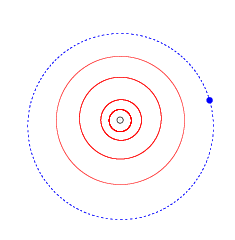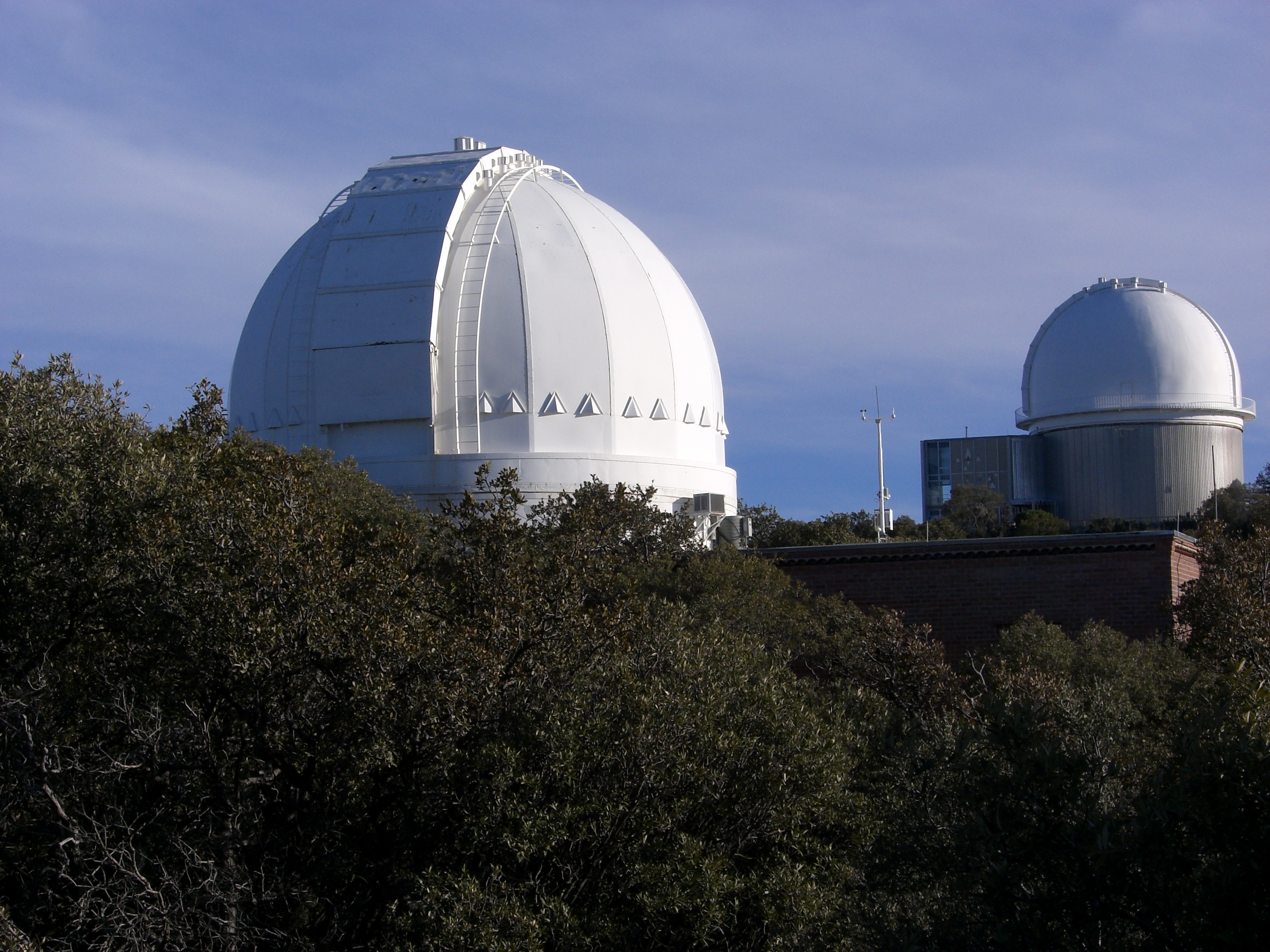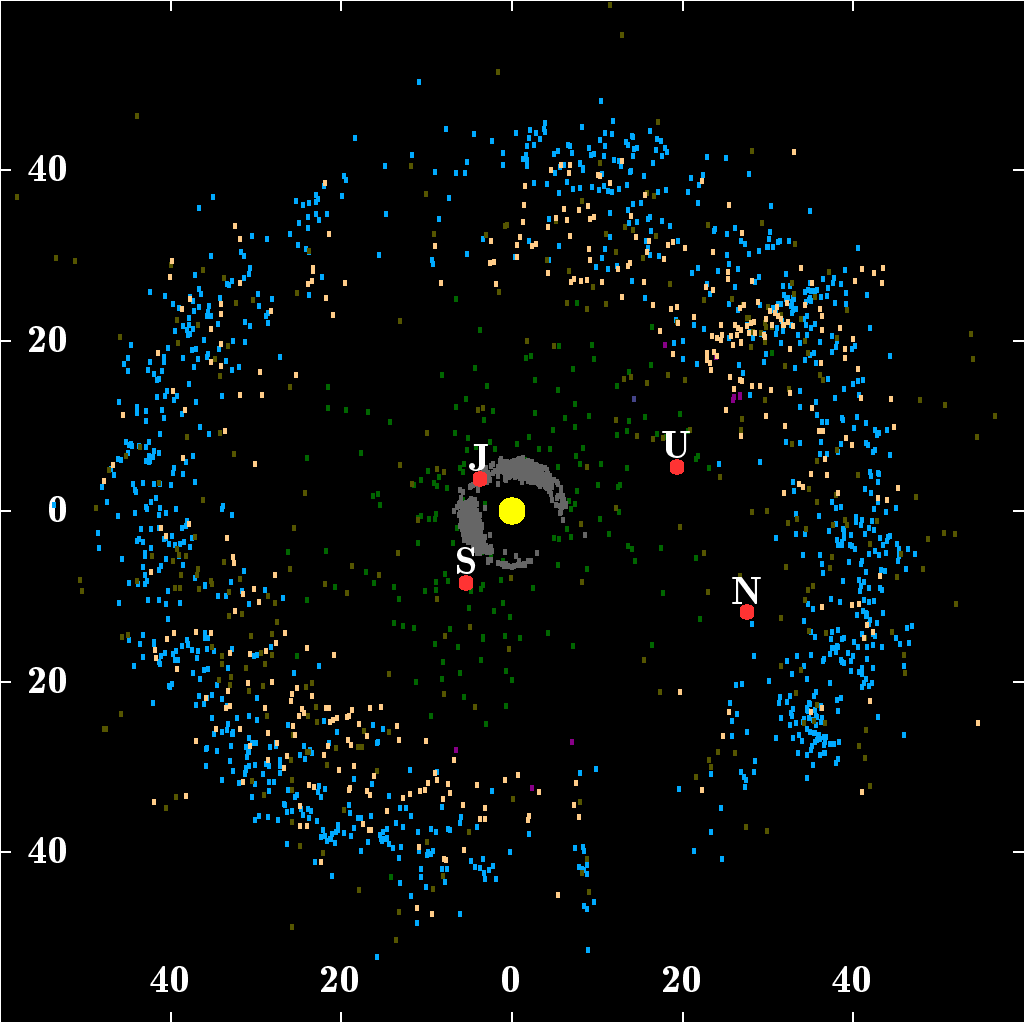|
Cubewano
A classical Kuiper belt object, also called a cubewano ( "QB1-o"), is a low-eccentricity Kuiper belt object (KBO) that orbits beyond Neptune and is not controlled by an orbital resonance with Neptune. Cubewanos have orbits with semi-major axes in the 40–50 AU range and, unlike Pluto, do not cross Neptune's orbit. That is, they have low-eccentricity and sometimes low-inclination orbits like the classical planets. The name "cubewano" derives from the first trans-Neptunian object (TNO) found after Pluto and Charon: 15760 Albion, which until January 2018 had only the provisional designation (15760) . Similar objects found later were often called "QB1-os", or "cubewanos", after this object, though the term "classical" is much more frequently used in the scientific literature. Objects identified as cubewanos include: * 15760 Albion (aka and gave rise to term 'Cubewano') * 136472 Makemake, the largest known cubewano and a dwarf planet * 50000 Quaoar and 20000 Varuna ... [...More Info...] [...Related Items...] OR: [Wikipedia] [Google] [Baidu] |
Plutino
In astronomy, the plutinos are a dynamical group of trans-Neptunian objects that orbit in 2:3 mean-motion resonance with Neptune. This means that for every two orbits a plutino makes, Neptune orbits three times. The dwarf planet Pluto is the largest member as well as the namesake of this group. The next largest members are , , and . Plutinos are named after mythological creatures associated with the underworld. Plutinos form the inner part of the Kuiper belt and represent about a quarter of the known Kuiper belt objects. They are also the most populous known class of resonant trans-Neptunian objects ''(also see adjunct box with hierarchical listing)''. The first plutino after Pluto itself, (385185) 1993 RO, was discovered on September 16, 1993. Orbits Origin It is thought that the objects that are currently in mean orbital resonances with Neptune initially followed a variety of independent heliocentric paths. As Neptune migrated outward early in the Solar System's his ... [...More Info...] [...Related Items...] OR: [Wikipedia] [Google] [Baidu] |
53311 Deucalion
53311 Deucalion ( provisional designation ) is a trans-Neptunian object from the classical Kuiper belt, with a diameter of approximately , located in the outermost region of the Solar System. The cubewano belongs to the cold population and was discovered on 18 April 1999, by the Deep Ecliptic Survey at the Kitt Peak National Observatory in Arizona, United States. It was named after Deucalion, from Greek mythology. Orbit and classification Deucalion orbits the Sun at a distance of 41.4–47.4 AU once every 295 years and 10 months (108,044 days; semi-major axis of 44.4 AU). Its orbit has an eccentricity of 0.07 and an inclination of 0 ° with respect to the ecliptic. The body's observation arc begins six days prior to its official discovery observation in April 1999. It is a cubewano from the classical Kuiper belt, located in between the resonant plutino and twotino populations and has a low-eccentricity orbit. With its very small inclination (0.3°), significantl ... [...More Info...] [...Related Items...] OR: [Wikipedia] [Google] [Baidu] |
Dwarf Planet
A dwarf planet is a small planetary-mass object that is in direct orbit around the Sun, massive enough to be hydrostatic equilibrium, gravitationally rounded, but insufficient to achieve clearing the neighbourhood, orbital dominance like the eight classical planets of the Solar System. The prototypical dwarf planet is Pluto, which for decades was regarded as a planet before the "dwarf" concept was adopted in 2006. Dwarf planets are capable of being geologically active, an expectation that was borne out in 2015 by the ''Dawn (spacecraft), Dawn'' mission to and the ''New Horizons'' mission to Pluto. planetary geology, Planetary geologists are therefore particularly interested in them. Astronomers are in general agreement that at least the List of possible dwarf planets#Likeliest dwarf planets, nine largest candidates are dwarf planets – in rough order of diameter, , , , , , , , , and . A considerable uncertainty remains over the tenth largest candidate , which may thus be co ... [...More Info...] [...Related Items...] OR: [Wikipedia] [Google] [Baidu] |
15760 Albion
15760 Albion ( provisional designation ) was the first trans-Neptunian object to be discovered after Pluto and Charon. Measuring about 108–167 kilometres in diameter, it was discovered in 1992 by David C. Jewitt and Jane X. Luu at the Mauna Kea Observatory, Hawaii. After the discovery, they dubbed the object "Smiley" and it was shortly hailed as the tenth planet by the press. It is a "cold" classical Kuiper belt object and gave rise to the name ''cubewano'' for this kind of object, after the portion of its designation. Decoding its provisional designation, "QB1" reveals that it was the 27th object found in the second half of August of that year. As of January 2018, around 2,400 further objects have been found beyond Neptune, a majority of which are classical Kuiper belt objects. It was named after Albion from William Blake's mythology. Naming This minor planet was named after Albion from the complex mythology of English poet and painter William Blake (1757–1827). ... [...More Info...] [...Related Items...] OR: [Wikipedia] [Google] [Baidu] |
50000 Quaoar
Quaoar ( minor-planet designation: 50000 Quaoar) is a ringed dwarf planet in the Kuiper Belt, a ring of many icy planetesimals beyond Neptune. It has an elongated ellipsoidal shape with an average diameter of , about half the size of the dwarf planet Pluto, and is a possible dwarf planet. The object was discovered by American astronomers Chad Trujillo and Michael Brown at the Palomar Observatory on 4 June 2002. Quaoar's surface contains crystalline water ice and ammonia hydrate, which suggests that it might have experienced cryovolcanism. A small amount of methane is present on its surface, which is only retained by the largest Kuiper belt objects. Quaoar has one known moon, Weywot, which was discovered by Brown in February 2007. Both objects were named after mythological figures from the Native American Tongva people in Southern California. Quaoar is the Tongva creator deity and Weywot is his son. In 2023, astronomers announced the discovery of two thin rings orb ... [...More Info...] [...Related Items...] OR: [Wikipedia] [Google] [Baidu] |
486958 Arrokoth
486958 Arrokoth (Provisional designation in astronomy, provisional designation ; formerly nicknamed Ultima Thule) is a trans-Neptunian object located in the Kuiper belt. Arrokoth became the farthest and most primitive List of minor planets visited by spacecraft, object in the Solar System visited by a spacecraft when the NASA space probe ''New Horizons'' conducted a flyby on 1 January 2019. Arrokoth is a Contact binary (small Solar System body), contact binary long, composed of two planetesimals across, that are joined along their major axes. With an orbital period of about 298 years and a low orbital inclination and orbital eccentricity, eccentricity, Arrokoth is classified as a cold classical Kuiper belt object. Arrokoth was discovered on 26 June 2014 by astronomer Marc Buie and the New Horizons Search Team, ''New Horizons'' Search Team using the Hubble Space Telescope as part of a search for a Kuiper-belt object for ''New Horizons'' to target in its fir ... [...More Info...] [...Related Items...] OR: [Wikipedia] [Google] [Baidu] |
58534 Logos
58534 Logos, or as a binary system (58534) Logos-Zoe, is a trans-Neptunian object and binary system from the classical Kuiper belt, approximately in diameter. The bright cubewano belongs to the cold population and has a 66-kilometer (41 miles) sized companion named Zoe. The system mass is . In the Gnostic tradition, Logos and Zoe are a paired emanation of the deity, and part of its creation myth. Zoe Logos is a binary with the components of comparable size orbiting the barycentre on a moderately elliptical orbit. Logos was discovered on 4 February 1997, and its companion, Zoe, was discovered on 17 November 2001 from Hubble Space Telescope observations by K. S. Noll, D. C. Stephens, W. M. Grundy, J. Spencer, Robert Millis, Marc Buie, Dale Cruikshank, S. C. Tegler, and W. Romanishin and announced on 11 February 2002. After the discovery, it received the provisional designation . Once confirmed it was officially designated (58534) Logos I and named Zoe. It orbits Logo ... [...More Info...] [...Related Items...] OR: [Wikipedia] [Google] [Baidu] |
19521 Chaos
19521 Chaos is a cubewano, a Kuiper belt, Kuiper-belt object not in orbital resonance, resonance with any planet. Chaos was discovered in 1998 by the Deep Ecliptic Survey with Kitt Peak National Observatory, Kitt Peak's 4 m telescope. Occultations suggest it is a compact or Contact binary (small Solar System body), contact binary equivalent to a sphere 400 to 500 km in diameter. On 20 November 2020, Chaos stellar occultation, occulted a magnitude 16.8 star. Three observers detected the occultation, finding that the object is likely smaller than in diameter. Another occultation was recorded on 14 January 2022; full results on size, shape, geometric albedo, and the spin-axis orientation have not been released. A further occultation occurred on 28 September 2023, with a shadow crossing most of North America. This occultation was observed by over 30 observers; preliminary analysis suggests that Chaos is a binary (possibly a contact binary). Name It is named after Chaos (cosmo ... [...More Info...] [...Related Items...] OR: [Wikipedia] [Google] [Baidu] |
20000 Varuna
20000 Varuna (provisional designation ) is a large trans-Neptunian object in the Kuiper belt. It was discovered in November 2000 by American astronomer Robert McMillan during a Spacewatch survey at the Kitt Peak National Observatory. It is named after the Hindu deity Varuna, one of the oldest deities mentioned in the Vedic texts. Varuna's light curve is compatible with the body being a Jacobi ellipsoid, suggesting that it has an elongated shape due to its rapid rotation. Varuna's surface is moderately red in color due to the presence of complex organic compounds on its surface. Water ice is also present on its surface, and is thought to have been exposed by past collisions which may have also caused Varuna's rapid rotation. Although no natural satellites have been found or directly imaged around Varuna, analysis of variations in its light curve in 2019 suggests the presence of a possible satellite orbiting closely around Varuna. Assumptions that the body is in hydrostatic e ... [...More Info...] [...Related Items...] OR: [Wikipedia] [Google] [Baidu] |
Trans-Neptunian Object
A trans-Neptunian object (TNO), also written transneptunian object, is any minor planet in the Solar System that orbits the Sun at a greater average distance than Neptune, which has an orbital semi-major axis of 30.1 astronomical units (AU). Typically, TNOs are further divided into the classical and resonant objects of the Kuiper belt, the scattered disc and detached objects with the sednoids being the most distant ones. As of February 2025, the catalog of minor planets contains 1006 numbered and more than 4000 unnumbered TNOs. However, nearly 5900 objects with semimajor axis over 30 AU are present in the MPC catalog, with 1009 being numbered. The first trans-Neptunian object to be discovered was Pluto in 1930. It took until 1992 to discover a second trans-Neptunian object orbiting the Sun directly, 15760 Albion. The most massive TNO known is Eris, followed by Pluto, , , and . More than 80 satellites have been discovered in orbit of trans-Neptunian objects. TNOs ... [...More Info...] [...Related Items...] OR: [Wikipedia] [Google] [Baidu] |
Kuiper Belt
The Kuiper belt ( ) is a circumstellar disc in the outer Solar System, extending from the orbit of Neptune at 30 astronomical units (AU) to approximately 50 AU from the Sun. It is similar to the asteroid belt, but is far larger—20 times as wide and 20–200 times as massive. Like the asteroid belt, it consists mainly of small Solar System body, small bodies or remnants from when the Formation and evolution of the Solar System, Solar System formed. While many asteroids are composed primarily of rock (geology), rock and metal, most Kuiper belt objects are composed largely of frozen Volatile (astrogeology), volatiles (termed "ices"), such as methane, ammonia, and water. The Kuiper belt is home to most of the objects that astronomers generally accept as dwarf planets: 90482 Orcus, Orcus, Pluto, Haumea, 50000 Quaoar, Quaoar, and Makemake. Some of the Solar System's natural satellite, moons, such as Neptune's Triton (moon), Triton and Saturn's Phoebe (moon), Phoebe, may ha ... [...More Info...] [...Related Items...] OR: [Wikipedia] [Google] [Baidu] |










